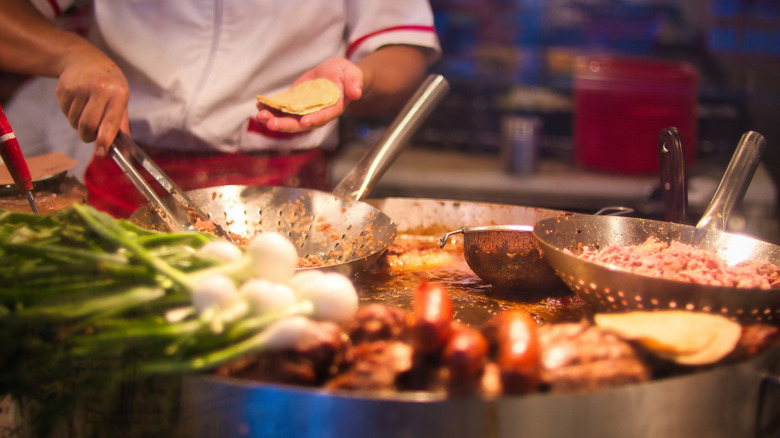Menudo Vs Pozole: The Difference Between The Mexican Soups
We may receive a commission on purchases made from links.
From the seven moles of Oaxaca to the infinite number of al pastor recipes, Mexican cuisine has no shortage of variety. But when it comes to soup, those not from the country often get menudo and pozole confused. While equally delicious, Jenny Martinez, cookbook author and social media personality, spoke to Food Republic to set the record straight on their similarities and differences.
"They both originated from central Mexico[;] however[,] everyone makes it very different," said Martinez. She noted that, while not traditional, "Some regions add hominy to menudo." What makes both soups so similar is their bases: a salty, meat-laden broth rich in fat and seasonings. Both have a rojo variation, rich in chile peppers; a verde type, leaning on tomatillos and cilantro; and a blanco version, without any chiles except maybe some jalapeño. "For both soups[,] you add radish, lime, tortillas, sal y salsa," Martinez continued.
Regional variations of each dish may give them some similarities, but most of the time, you wouldn't get them confused seeing them side by side. The meat is what really separates the two; pozole mostly relies on pork and chicken, yet menudo often uses organ meat like beef tripe, sheep stomach, kidneys, or even cow's feet. Some folks even add seafood to pozole, something you'd never see with menudo. When you factor in other ingredients, preparation methods, and serving traditions, the two recipes couldn't be more different, despite both being delicious, homey meals.
Menudo is a family-style meal born from necessity
Most people consider menudo as a family-style breakfast food, one you would rarely make for yourself unless you're in desperate need of its hangover-curing properties. Born from a tradition of having to make do with what you're given during a period of food scarcity, it's now a beloved dish across Mexico and the USA.
While pozole is a relatively quick recipe, nothing could be further from the truth for menudo. "Menudo comes with an extensive preparation[;] you need to clean the beef tripe, honeycomb[,] and stomach (lining of the cow) really well," Jenny Martinez told us. "Additionally, I like to soak it in vinegar, lemon[,] and salt for about 30 minutes before cooking it." Even if your butcher does most of the work for you, tripe is only edible after boiling for five minutes to an hour, making it more labor-intensive than most meats. And that's before you factor in making a stock out of simmered cow's feet and other parts — something that could take at least four or five hours.
Martinez pointed out that oregano is a small — but very noticeable — difference between the soups as well. This is especially true when using Mexican oregano, which has a powerful floral flavor compared to European varieties. For menudo blanco, you get something rich and salty, comparable to a tonkotsu ramen or classic Western beef stew. Menudo rojo may leave you sweating with each bite, but between the chewiness of the tripe and the unforgettable combination of lime and oregano, you won't be able to stop eating.
Pozole brings comfort to celebrations like Independence Day
Whereas menudo's history comes from turning cast-off parts into something delicious, pozole has always had a happier history. A classic one-pot dish served on Mexican Independence Day, it typically marks a celebration of some kind, one that anyone would look forward to after getting a taste.
"Pozole is [simpler;] you throw everything into the pot and kind of 'set and forget it' until it's time to make the sauce," explained Jenny Martinez. Much like menudo, you need to simmer a big piece of bone-in chicken or pork to make the stock. Unlike most menudo recipes, however, you'll also be simmering a pot of hominy. When the shredded meat and hominy combine in the stock, it creates something similar to an extra-flavorful chicken noodle soup — half starch, half protein, all with plenty of salt.
When it comes to taste, pozole is far lighter than menudo, even with a hefty dose of hominy bulking it out. This is especially true of pozole verde, which has tons of acid and vegetable taste to complement the chicken. The tender hominy and simmered shreds of pork or chicken give it an almost creamy texture, particularly if you simmer the stock at a higher temperature to make it extra rich and pale. Whereas menudo gives you enough protein to tackle a day of hard labor, pozole is better as a mid-day meal when you don't want to be weighed down by a dish that's too heavy.



